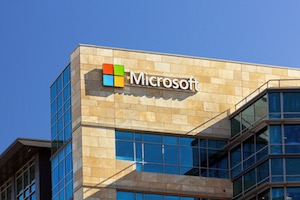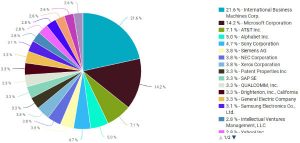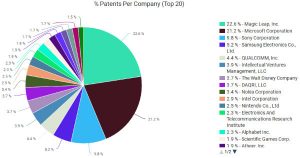
Microsoft corporate building in Santa Clara, California.
America’s “Big 5” tech companies have been chugging forward with patenting activities in recent years, according to mid-December reports of data released from venture capital resource firm CB Insights. This data suggests that since 2009, a total of 52,000 patent applications have been filed by a collection of five tech giants: Alphabet Inc. (NASDAQ:GOOGL) subsidiary Google; Apple Inc. (NASDAQ:AAPL); Facebook, Inc. (NASDAQ:FB); Amazon.com (NASDAQ:AMZN); and Microsoft Corp. (NASDAQ:MSFT). The report sheds a little bit of light on the tech sectors where each of these major tech companies are trying to stake their claims.
In terms of sheer numbers, in the CB Insights study, which curiously did not include patent giant and American research juggernaut IBM, Microsoft ranks supreme among this collection of five major tech firms. The Redmond, WA-based hardware and software developer has applied for a total of 16,840 patents over the seven years of the study. In second place is Google with 14,596 patent applications over the same time period. Although exact numbers for the other three firms weren’t publicly released by CB Insights, these two firms are followed by Apple (13,420 patent applications), Amazon (5,186) and Facebook (2,508), respectively.
Collectively, these five tech companies have been pushing towards a total of 10,000 patent applications filed per year. This trend marks a sharp rise in patent application filing activities among the Big 5, which filed 3,565 patent applications collectively in 2009 and 9,804 patent application in 2013. Data published by CB Insights indicates that totals from 2014 onward are only to date, so those totals could increase with patent applications published in the future by the U.S. Patent and Trademark Office.
It deserves further mention that this particular collection of Big 5 tech companies would be quite different had CB Insights included IBM. It is indeed hard to understand how CB Insights could leave off patenting giant IBM (NYSE:IBM), the major tech company that has earned the most U.S. patents each year for the past 23 years. In any event, these numbers on patents filed by American high tech firms and the growth identified would have been much higher in a different study that included the obvious leader of the pack — IBM. For example, in 2015 alone IBM received 7,355 patents, which dwarfs the number of patent applications even filed by Amazon and Facebook since 2009.
Artificial intelligence (AI) technologies are one sector of research and development where the CB Insights study compares the patenting activities of these Big 5. These innovations will enable cognitive functions in machines and impact a wide range of industries in the years to come, including agriculture, healthcare, retail, manufacturing and transportation. Global market research firm MarketsandMarkets forecasts that the global AI market will reach $16.06 billion USD by the year 2022, growing at a compound annual growth rate (CAGR) of 62.9 percent between 2016 and 2022. American market intelligence firm Tractica recently released an market taxonomy of 27 industry sectors featuring potential AI use-cases and forecast that global AI revenue would grow from $643.7 million in 2016 up to $38.8 billion in 2025. Natural language processing, deep learning and other AI tech will be incredibly valuable for their ability to support new business models according to the above analysis.
 Among the Big 5, Microsoft holds the lead in AI technologies with 200 patent applications filed since 2009. Google trails in second place with upwards of 150 patent applications in the field. CB Insights identifies Apple as being the laggard in this sector with only 15 patent applications and even notes that the Cupertino, CA-based tech firm has been slow to adopt this sector of technology, likely hurting its chances to take greater gains from the market as it grows. The patent portfolio analysis tools available through Innography further support the idea that CB Insights maybe should have explored IBM’s patenting activities in this study, seeing as the company accounts for more than one-fifth of all U.S. patent applications filed to protect AI technologies according to this pie chart. Although the numbers returned by Innography are lower than those reported by CB Insights, it still supports the idea that Microsoft and Google are the top two players in this field among the Big 5. Amazon saw 41 AI patent applications published over the survey period while Facebook has had 36 AI patent applications published.
Among the Big 5, Microsoft holds the lead in AI technologies with 200 patent applications filed since 2009. Google trails in second place with upwards of 150 patent applications in the field. CB Insights identifies Apple as being the laggard in this sector with only 15 patent applications and even notes that the Cupertino, CA-based tech firm has been slow to adopt this sector of technology, likely hurting its chances to take greater gains from the market as it grows. The patent portfolio analysis tools available through Innography further support the idea that CB Insights maybe should have explored IBM’s patenting activities in this study, seeing as the company accounts for more than one-fifth of all U.S. patent applications filed to protect AI technologies according to this pie chart. Although the numbers returned by Innography are lower than those reported by CB Insights, it still supports the idea that Microsoft and Google are the top two players in this field among the Big 5. Amazon saw 41 AI patent applications published over the survey period while Facebook has had 36 AI patent applications published.
As the recent CB Insights report suggests, vehicle technologies have been an area of greater R&D investment among members of tech’s Big 5 in recent years. Google has been identified in the past as being particularly invested in this sector and the recent Big 5 report reflects this, placing Google at the top of the list among the tech companies surveyed; CB Insights identified 365 vehicle patent applications filed by the firm. Google has a sizable lead over rival firm Apple (65 patent applications), which in turn is followed by Microsoft (63) and then Amazon (32). No Facebook patent applications were identified in this field.
 Despite the focus on Silicon Valley’s contributions to recent development in automotive technologies, their impact on this sector will probably be more limited in scope. None of the Big 5 identified by CB Insights comes up in the top 20 organizations filing vehicle-related patent applications since the beginning of 2009, according to Innography. As this pie chart shows, the sector is dominated by usual suspects like Toyota (NYSE:TM), Ford (NYSE:F) and General Motors (NYSE:GM). The only American tech firm that shows up in the top 20 is General Electric (NYSE:GE), which has filed just under 2 percent of U.S. patent applications for vehicle technologies since the beginning of 2009. Technological developments in on-demand mobility services and data-driven services could potentially create additional revenues in the automotive industry of $1.5 trillion according to data released by global consulting firm McKinsey & Company.
Despite the focus on Silicon Valley’s contributions to recent development in automotive technologies, their impact on this sector will probably be more limited in scope. None of the Big 5 identified by CB Insights comes up in the top 20 organizations filing vehicle-related patent applications since the beginning of 2009, according to Innography. As this pie chart shows, the sector is dominated by usual suspects like Toyota (NYSE:TM), Ford (NYSE:F) and General Motors (NYSE:GM). The only American tech firm that shows up in the top 20 is General Electric (NYSE:GE), which has filed just under 2 percent of U.S. patent applications for vehicle technologies since the beginning of 2009. Technological developments in on-demand mobility services and data-driven services could potentially create additional revenues in the automotive industry of $1.5 trillion according to data released by global consulting firm McKinsey & Company.
Finally, the CB Insights report on the patent application filing activities of the Big 5 looks at the twin sectors of virtual reality (VR) and augmented reality (AR). Both of these industries are set to see major increases in the size of their markets in the coming years. Brand consulting firm Deloitte indicated that the VR industry was set to hit $1 billion by the end of 2016, with $700 million of that total coming from the sale of hardware devices and much of the commercial focus on video games and entertainment products. According to a summary of a Business Insider market report, the combined market for VR and AR tech could hit $162 billion by 2020. Augmented realities will likely provide the vast majority of these revenues. A May 2016 report from MarketsandMarkets forecasts the global AR market to grow at an annual CAGR of 75.72 percent through 2022, when that market is predicted to reach $117.4 billion USD. Over the same period, VR tech is expected to grow at a CAGR of 57.84 percent to reach $33.9 billion by 2022.
 Microsoft, which has been heralding the development of its HoloLens VR platform and Kindle AR tech in recent years, takes the lead position in this field with 141 VR/AR patent applications, followed by Google (45), Amazon (33) and then Apple (12). Again, no Facebook patent applications were identified in this field. A fuller view of the VR/AR market provided by Innography shows Microsoft being outpaced slightly by Florida-based mixed reality developer Magic Leap, Inc. Near the top of the list and trailing Microsoft closely are Sony Corp. (NYSE:SNE), Samsung Electronics (KRX:005930) and Qualcomm, Inc. (NASDAQ:QCOM).
Microsoft, which has been heralding the development of its HoloLens VR platform and Kindle AR tech in recent years, takes the lead position in this field with 141 VR/AR patent applications, followed by Google (45), Amazon (33) and then Apple (12). Again, no Facebook patent applications were identified in this field. A fuller view of the VR/AR market provided by Innography shows Microsoft being outpaced slightly by Florida-based mixed reality developer Magic Leap, Inc. Near the top of the list and trailing Microsoft closely are Sony Corp. (NYSE:SNE), Samsung Electronics (KRX:005930) and Qualcomm, Inc. (NASDAQ:QCOM).
The full report itself goes on to describe the technologies covered by patent application portfolios held by each of the Big 5 included in the report. As a full snapshot of the patenting activities of major American tech firms, the recent CB Insights study leaves a bit to be desired, mostly due to the absence of important tech players like IBM and GE. It does, however, provide an interesting look into the R&D focus for a handful of America’s most recognizable tech companies.

![[IPWatchdog Logo]](https://ipwatchdog.com/wp-content/themes/IPWatchdog%20-%202023/assets/images/temp/logo-small@2x.png)

![[[Advertisement]]](https://ipwatchdog.com/wp-content/uploads/2023/01/2021-Patent-Practice-on-Demand-1.png)
![[Advertisement]](https://ipwatchdog.com/wp-content/uploads/2024/04/UnitedLex-May-2-2024-sidebar-700x500-1.jpg)
![[Advertisement]](https://ipwatchdog.com/wp-content/uploads/2024/04/Artificial-Intelligence-2024-REPLAY-sidebar-700x500-corrected.jpg)
![[Advertisement]](https://ipwatchdog.com/wp-content/uploads/2024/04/Patent-Litigation-Masters-2024-sidebar-700x500-1.jpg)

![[Advertisement]](https://ipwatchdog.com/wp-content/uploads/2021/12/WEBINAR-336-x-280-px.png)
![[Advertisement]](https://ipwatchdog.com/wp-content/uploads/2021/12/2021-Patent-Practice-on-Demand-recorded-Feb-2021-336-x-280.jpg)
![[Advertisement]](https://ipwatchdog.com/wp-content/uploads/2021/12/Ad-4-The-Invent-Patent-System™.png)






Join the Discussion
15 comments so far.
H2H
January 14, 2017 05:29 amWho is filing all these patents? It’s curious, based on public info about 410,000 new applications filed in 2015 (non-RCE), and available data on filers (law firms, corporations) filing new applications in 2015 accounts for about 220,000 applications. Who filed the other 200,000?
Inventor Woes
December 28, 2016 01:34 pmstep back @11
The terms “jabberwhock” and “jabberwhacky” sound eerily familiar to the term “cuck” that is thrown around a lot. It just seems like name-calling without addressing the underlying concerns.
step back
December 27, 2016 02:33 pmThere is no legitimate, bright line definition to “software” just as there are no legitimate bright line definitions to many other words like beauty, porn, freedom, truth, etc., etc.
Any invention that in some way or another utilizes a programmed machine might be characterized (or mischaracterized) as being described by a “software” patent. That means that a novel, useful and nonobvious automobile engine that relies at least in part (even a very small part) on a programmed machine might be characterized as a “software” invention.
The better approach is to avoid using nonsense phrases like “software patent”.
Every patent is unique because it is disclosing a new invention.
Inventor Woes
December 27, 2016 01:49 pmIf the term “software patent” is nonsense as you say, doesn’t that add to the arguments of the other guys. Shouldn’t we fight back with legitimate definitions?
step back
December 27, 2016 10:30 amInventor Woes @9
Happy New Year.
Obviously you enjoy the attention you are getting here.
Unfortunately the questions and positions you pose are 90% jabberwhacky.
There is no clear cut definition of what “software” is is.
That problem is compound by the nonsense phrase of “software patent”.
What makes one patent a non-software one and the other a software one?
Then again we have no idea what you mean by “the whole field”.
Perhaps the Donald should appoint you to be a member of the SCOTeti.
They tend to ask jabberwhacky questions similar to yours during oral hearings.
Solvency. King Tut’s abacus man. Know what I mean?
Cheers
Night Writer
December 27, 2016 10:22 am@9 Inventor Woes It means that “software” should be treated like any other invention. 102/103/112. No witch hunt.
Inventor Woes
December 27, 2016 12:59 amNight Writer @8
So does that mean that the whole field is pre-empted by a software patent?
Night Writer
December 26, 2016 10:12 pmWhat strikes me about the “software” arguments is the way people like Mayer have tried to generate new laws for “software” distinguishing the “software” in ways that are artificial. The reality is that “software” is just like other types of inventions. And, the reality is that there is no principled way to distinguish between software/firmware/special purpose hardware.
Inventor Woes
December 25, 2016 08:55 pmstep back @6
What exactly does “Supreme Court Officials Taken each thereby individually” mean? I’m still not clear on this.
step back
December 25, 2016 10:50 amSupreme Court Officials Taken each thereby individually
Don’t ask me who the Jabberwock is 😉
Happy Holidays and Festive Festivus to all
Inventor Woes
December 25, 2016 12:47 amstep back @4
What is SCOTeti?
step back
December 23, 2016 11:08 amNo. You misunderstand.
Here is what the SCOTeti actually said …. 😉
’Twas brillig, and the slithy toves
Did gyre and gimble in the wabe:
All mimsy were the borogoves,
And the mome raths outgrabe.
“Beware the Jabberwock, my son!
The jaws that bite, the claws that catch!
The patent scriveners who deceive!
Inventor Woes
December 22, 2016 11:00 pmSo if I understand it correctly, there must be a technical solution to a technical problem. However it can’t be an abstract idea unless it’s substantially more inventive than the idea itself? So for example, if I come up with a new encryption method, would that be a technical solution to a problem or would it be an abstract idea?
Gene Quinn
December 22, 2016 02:28 pmInventor Woes-
The Mayer concurrence in Intellectual Ventures was an embarrassment. See:
https://ipwatchdog.com/2016/10/06/judge-mayer-step-down-federal-circuit/id=73567/
But Mayer’s views are a minority view of the Federal Circuit. At this point he has the most extreme views, followed by Judge Dyk. Everyone else would really disagree with pretty much everything Judge Mayer writes. He is flat wrong on the law. No room for debate. Mayer makes things up and then provides citations to the Supreme Court for his extremist views. But if you read what he says supports him you realize very quickly that he is misrepresenting things (to give him the benefit of the doubt). But given how often he does this it is hard to see it as anything other than fraud in my opinion.
To learn about software please read these articles. You will notice one is by Matt Levy. I like Matt but disagree with him on a lot of things. He is on the other side of the software debate from where I am in virtually all situations and he characterizes my articles as a fair summary and also acknowledges that software has a future if you describe it properly and actually have an innovation. So anyone telling you anything else is misguided.
https://ipwatchdog.com/2016/11/17/patent-software-post-alice/id=74750/
https://ipwatchdog.com/2016/11/20/guide-software-patent-eligibility-federal-circuit/id=74760/
https://ipwatchdog.com/2016/11/30/software-patents-will-survive/id=75101/
-Gene
Inventor Woes
December 22, 2016 12:14 pmI’ve been seeing rumblings on the web that software patents are doomed.
http://fortune.com/2016/10/03/software-patents/